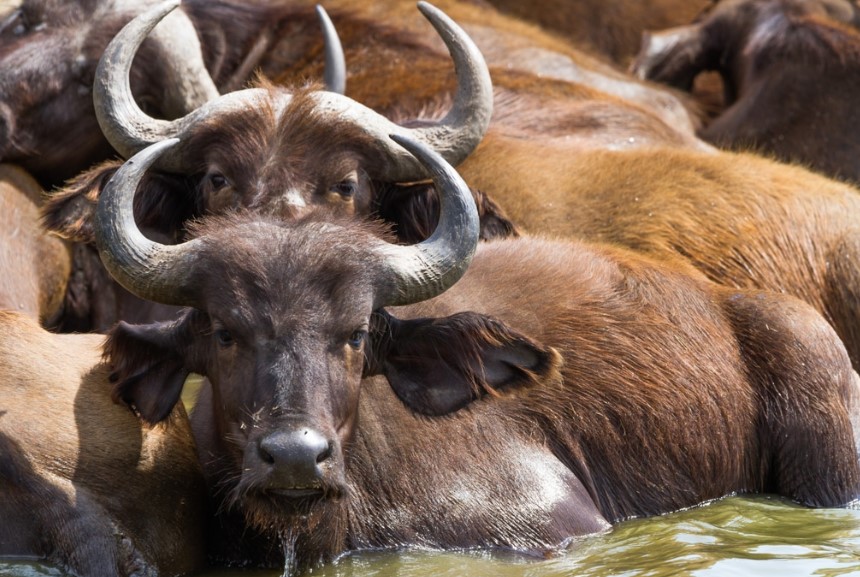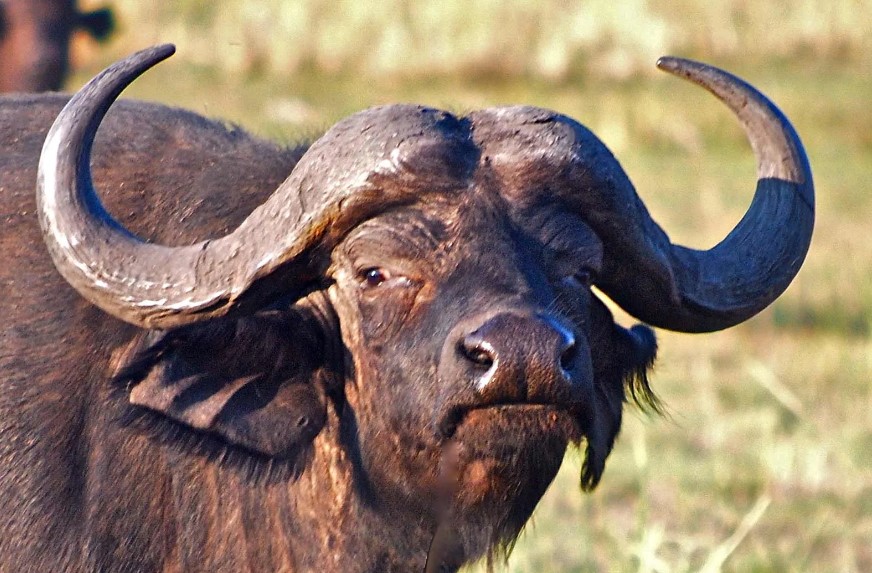The Life of Buffaloes in Uganda-Uganda is known for its diverse wildlife and natural beauty. Among the many iconic species that roam its vast landscapes, buffaloes hold a significant place. These majestic animals, scientifically known as Syncerus caffer, are an integral part of Uganda’s rich ecosystem. In this essay, we will delve into the life of buffaloes in Uganda, exploring their habitat, behavior, conservation status, and interactions with humans.
Buffaloes in Uganda primarily inhabit savannas, grasslands, and woodland areas. They are highly adaptable and can thrive in various ecosystems, ranging from the fertile plains of Queen Elizabeth National Park to the lush wetlands of Murchison Falls National Park. These habitats provide them with an abundant supply of grasses and water, essential for their survival.
Buffaloes are large and robust animals, with both males and females sporting distinctive curved horns. The males, called bulls, are considerably larger than the females, known as cows. Their sheer size and imposing appearance make buffaloes one of the most formidable creatures in the African wilderness. Adult males can weigh up to 900 kilograms (2000 pounds), and their horns can span up to 1.5 meters (5 feet) in length.
Buffaloes in Uganda are highly social animals, forming herds that can consist of several hundred individuals. These herds are led by dominant males, who establish a hierarchical order within the group. Female buffaloes and their offspring form the core of the herd, while adult males often roam alone or in small bachelor groups. This social structure ensures the safety and survival of the herd, as buffaloes exhibit cooperative behavior when facing threats from predators.

The diet of buffaloes primarily consists of grass, which they graze upon for several hours each day. They have a well-developed digestive system that allows them to efficiently extract nutrients from the tough grasses they consume. This grazing behavior also plays a crucial role in shaping the landscape, as buffaloes help maintain the balance between vegetation and grasslands, preventing the encroachment of forests into open areas.
Buffaloes in Uganda are not only remarkable for their ecological significance but also for their interaction with humans. Ugandan communities, particularly those residing near wildlife reserves, have learned to coexist with these magnificent creatures.
However, conflicts do arise, mainly when buffaloes venture into agricultural lands and destroy crops. Efforts have been made to implement strategies that minimize these conflicts, such as constructing buffer zones and providing alternative livelihood options for affected communities.
Uganda recognizes the importance of conserving its buffalo population and has established several protected areas to safeguard their habitat. National parks, such as Murchison Falls, Queen Elizabeth, and Kidepo Valley, serve as crucial sanctuaries for buffaloes and other wildlife. These protected areas not only provide a safe haven for buffaloes but also offer opportunities for tourism, contributing to the local economy.
Despite the conservation efforts, buffaloes in Uganda face various threats. Poaching for their meat and horns, habitat loss due to human encroachment, and diseases transmitted from livestock are some of the challenges they encounter. Additionally, climate change poses a long-term risk to their survival, as alterations in rainfall patterns and temperature can impact their habitat and food availability.
To address these threats, the Ugandan government, along with conservation organizations, has implemented measures to protect buffaloes and their habitat. Strict anti-poaching patrols, community-based conservation programs, and scientific research on buffalo populations have played a vital role in their preservation.
Furthermore, raising awareness among local communities about the importance of wildlife conservation and sustainable livelihoods is crucial in ensuring the long-term survival of buffaloes in Uganda. Education and outreach programs are conducted to highlight the ecological role of buffaloes and the benefits they bring to the local ecosystems.

Efforts are also being made to address human-wildlife conflicts through the implementation of innovative strategies. For instance, the establishment of community conservancies and wildlife corridors aims to create a harmonious balance between the needs of local communities and the conservation of buffaloes.
By providing alternative sources of income such as ecotourism and promoting sustainable agricultural practices, communities are encouraged to coexist with buffaloes and other wildlife.
Furthermore, collaborations between government agencies, non-governmental organizations, and international partners are instrumental in enhancing buffalo conservation efforts. These partnerships facilitate the sharing of knowledge, resources, and expertise, leading to more effective conservation strategies and initiatives.
In addition to local efforts, Uganda is also part of regional and international initiatives for wildlife conservation. It is a signatory to international agreements such as the Convention on International Trade in Endangered Species of Wild Fauna and Flora (CITES) and the African Convention on the Conservation of Nature and Natural Resources. These agreements promote cooperation among countries to protect endangered species like buffaloes and regulate the trade of their products.
The conservation status of buffaloes in Uganda is currently listed as “Least Concern” by the International Union for Conservation of Nature (IUCN). However, ongoing monitoring and research are essential to assess population trends, habitat quality, and the impact of various threats. These assessments inform conservation strategies and enable timely interventions to protect buffaloes and their habitat.
In conclusion, buffaloes play a vital role in Uganda’s ecosystem, and their conservation is crucial for maintaining the country’s biodiversity. The life of buffaloes in Uganda is intertwined with the livelihoods of local communities, the preservation of natural habitats, and the sustainable development of the nation.
Through concerted efforts in education, community engagement, habitat protection, and international collaborations, Uganda strives to ensure the long-term survival of these majestic creatures. By valuing the importance of wildlife conservation and sustainable practices, Uganda is working towards a future where buffaloes and humans can coexist harmoniously, securing the natural heritage of the “Pearl of Africa” for generations to come.


Comment (0)